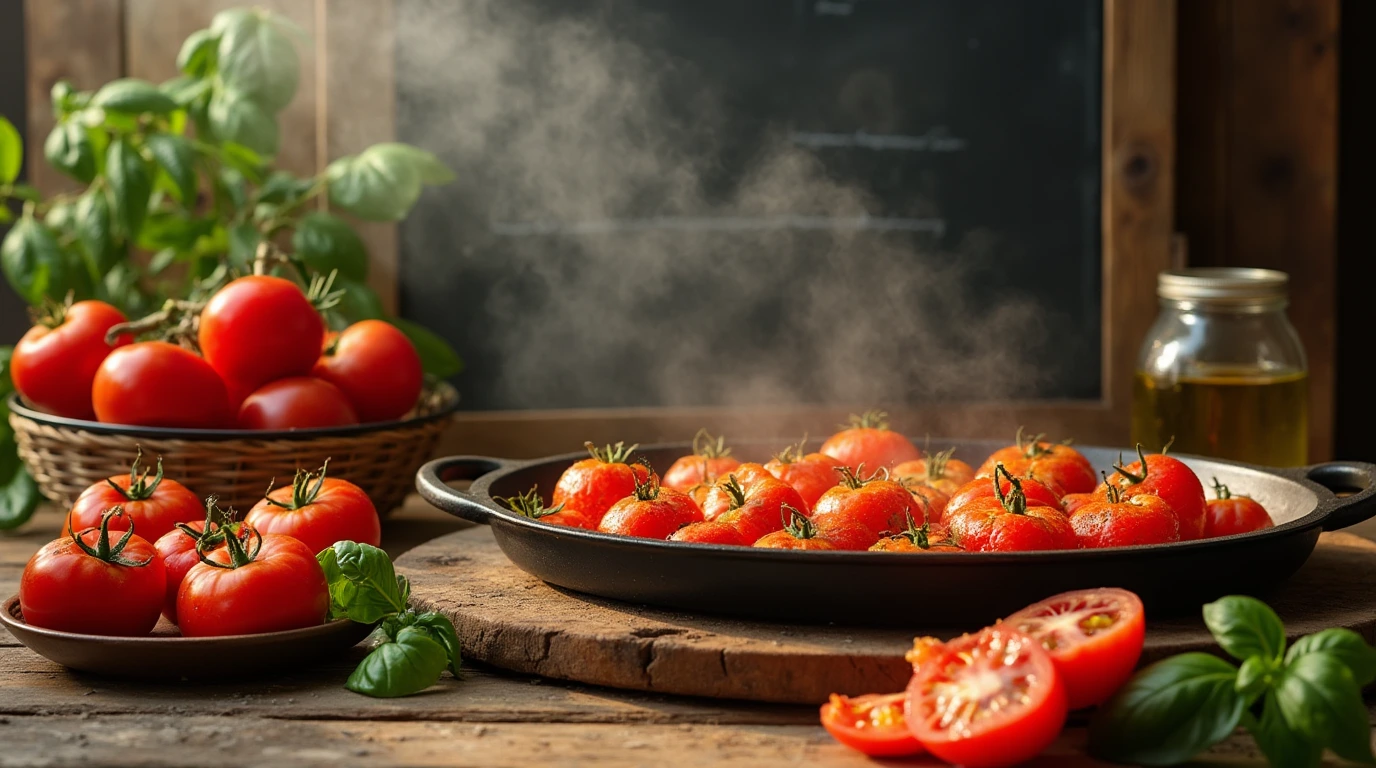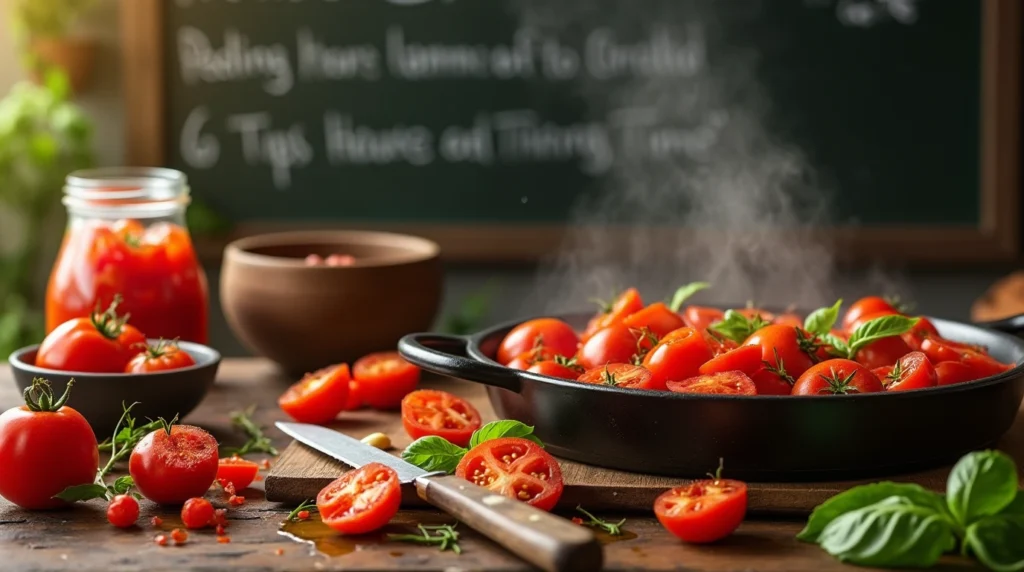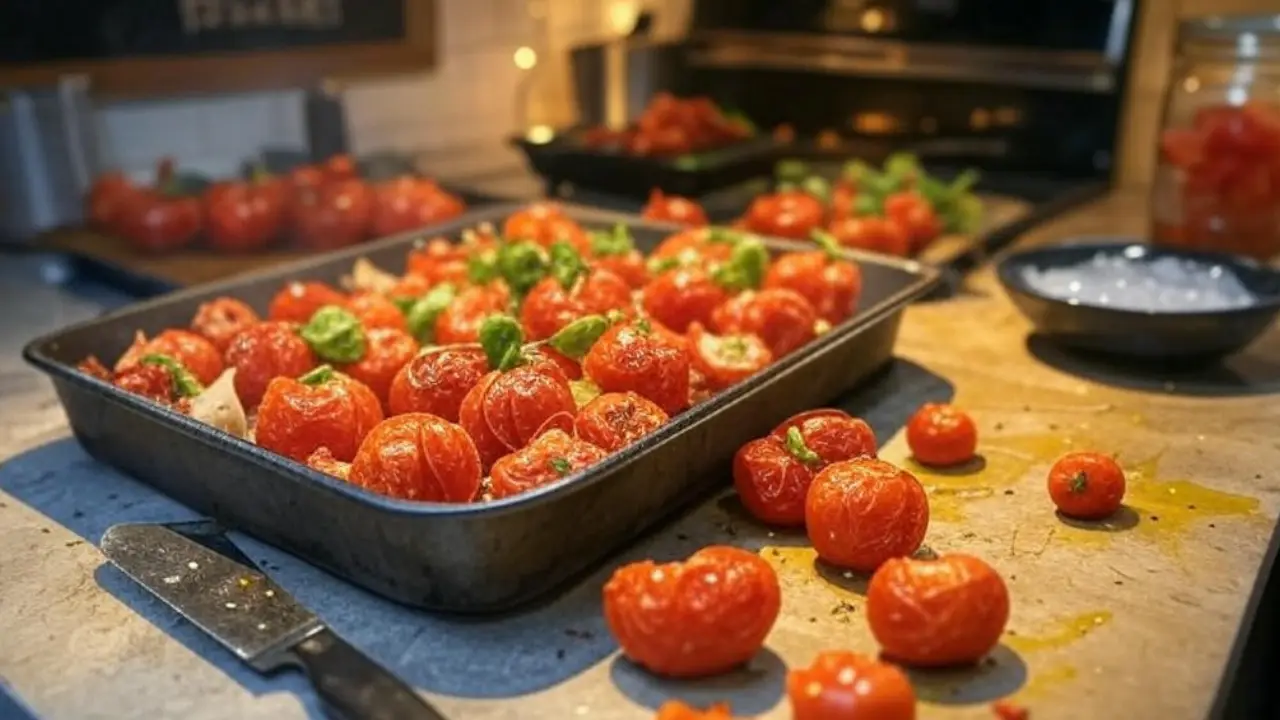Roasted tomatoes add depth and flavor to countless dishes, but a common question arises: “Do I need to peel tomatoes before roasting?” The answer depends on the dish you’re preparing and your personal preferences. Leaving the skin on can save time and add texture, while peeling ensures a smoother consistency in certain recipes.
In this guide, we’ll explore when to peel tomatoes, how to roast them with or without the skin, and which dishes benefit from one method over the other. Whether you’re making sauces, soups, or salads, you’ll learn the best approach for your roasted tomato needs.
Do I Need to Peel Tomatoes Before Roasting?
Whether or not to peel tomatoes before roasting depends on the dish you’re making and your desired texture. Here’s a breakdown of when it’s best to leave the skin on and when peeling might be necessary.
1. The Benefits of Leaving the Skin On
- Saves Time: Roasting tomatoes with the skin on eliminates the extra step of peeling, making the process quicker and easier.
- Adds Texture: The skin provides a slightly chewy texture that works well in rustic dishes like salads, roasted vegetable platters, and chunky pasta sauces.
- Concentrates Flavor: The skin helps lock in moisture and enhances the tomato’s natural sweetness as it caramelizes during roasting.
- Nutritional Value: Tomato skins contain fiber and antioxidants like lycopene, adding a health boost to your dishes.
2. When You Might Want to Peel Tomatoes
- For Smooth Sauces: Dishes like marinara sauce, tomato soup, or bisque benefit from peeled tomatoes to achieve a silky consistency.
- To Avoid Tough Textures: If the skins are thick or if you’re working with large tomatoes, peeling can help prevent a chewy texture.
- For Aesthetic Purposes: Peeling ensures a more uniform appearance in dishes where presentation matters, such as finely blended dips or spreads.
Pro Tip: You can leave the skin on for most applications and peel after roasting if needed. The skins loosen naturally during cooking, making them easy to remove.
How to Roast Tomatoes With the Skin On
Roasting tomatoes with the skin on is a simple, time-saving method that enhances their natural flavors. Here’s how to prepare and roast them perfectly.

1. Preparing Tomatoes for Roasting
- Choose the Right Tomatoes
- Cherry, grape, or Roma tomatoes work best with the skin on as their thinner skins caramelize beautifully during roasting.
- Wash and Dry
- Rinse the tomatoes under cold water and pat them dry with a clean towel.
- Slice for Even Cooking
- Slice larger tomatoes, like Romas, in half lengthwise. Leave smaller varieties, such as cherry or grape tomatoes, whole.
- Season Generously
- Place the tomatoes on a baking sheet. Drizzle with olive oil, sprinkle with salt and pepper, and add herbs like thyme, oregano, or basil for extra flavor.
2. Best Practices for Roasting Tomatoes With Skin
- Set the Oven Temperature
- Preheat your oven to 375°F-400°F. This range ensures the tomatoes caramelize without burning.
- Arrange Tomatoes on the Baking Sheet
- Place the tomatoes cut-side up for larger slices or in a single layer for smaller ones. Avoid overcrowding to allow even roasting.
- Roast Until Caramelized
- Roast for 20-30 minutes, checking for soft, caramelized edges. For larger tomatoes, roast closer to 40 minutes.
- Add Finishing Touches
- Once out of the oven, drizzle with balsamic glaze or sprinkle with fresh herbs to enhance the flavor.
Why Roasting with Skin Works
- Locks in Flavor: The skin traps moisture and juices during roasting, concentrating the tomato’s sweetness.
- Versatility: Roasted tomatoes with skin can be added to salads, sandwiches, or blended into sauces for a rustic texture.
How to Peel Tomatoes for Roasting
If you prefer a smoother texture or need peeled tomatoes for your dish, follow these easy methods to remove the skins before or after roasting.
1. Blanching and Peeling Tomatoes (Before Roasting)
Blanching is a quick way to peel tomatoes without affecting their flavor or texture.
- Boil Water
- Bring a large pot of water to a boil.
- Score the Tomatoes
- Using a sharp knife, make a small “X” at the base of each tomato. This helps loosen the skin during blanching.
- Blanch the Tomatoes
- Place the tomatoes in boiling water for 30-60 seconds, or until the skin begins to peel away.
- Cool in Ice Water
- Transfer the tomatoes immediately to an ice water bath to stop the cooking process.
- Peel the Skins
- Use your fingers or a knife to gently remove the loosened skin.
2. Peeling After Roasting
Roasting tomatoes with the skin on and peeling them afterward is another convenient option:
- Roast as Usual
- Follow the roasting instructions in the previous section, keeping the skin on during cooking.
- Cool Slightly
- Allow the roasted tomatoes to cool enough to handle safely.
- Remove the Skins
- Gently peel off the skin using your fingers. It should slide off easily, especially with larger varieties like Roma or vine-ripened tomatoes.
When to Peel Tomatoes
- Before Roasting: If the tomatoes will be used in a smooth sauce, peeling beforehand ensures a uniform texture.
- After Roasting: For recipes like soups or dips, peeling after roasting preserves more flavor while still achieving a smooth consistency.
Pro Tip: Reserve the peeled skins for making tomato powder or adding to broths for extra flavor.
Dishes Where Peeling Matters
Whether or not to peel your tomatoes before roasting often depends on the dish you’re preparing. Here’s a guide to help you decide when peeling is essential and when it’s not necessary.
1. Smooth Sauces and Soups
For recipes that require a silky texture, peeled tomatoes are essential to avoid bits of skin disrupting the consistency.
- Examples of Dishes:
- Marinara Sauce: Smooth and uniform, with no skin pieces.
- Tomato Soup: Velvety and creamy, perfect for dipping bread.
- Tomato Bisque: A rich, smooth soup that benefits from peeled tomatoes.
Why Peeling Matters: The skins don’t break down completely when blended, leading to an uneven texture in these dishes.
2. Chunky Dishes Where Skins Work
For rustic recipes or dishes with a hearty texture, leaving the skins on adds character and saves time.
- Examples of Dishes:
- Pasta with Roasted Tomatoes: Skins add a chewy, caramelized texture that enhances the dish.
- Roasted Vegetable Salads: The skins contribute to a rustic look and hold the tomatoes’ shape.
- Pizza Toppings: Skins help maintain structure and prevent the tomatoes from becoming overly mushy.
Why Skins Work: In these dishes, the skins provide a pleasing chew and hold up well under heat, adding a rich depth of flavor.
3. Blended or Chunky Sauces
For blended sauces, peeling may depend on personal preference. Skins can add a bit of texture but might feel intrusive in smoother recipes.
- Blended Sauce Tip: If you prefer a silky sauce but want to save time, roast the tomatoes with the skin on and strain the sauce through a fine sieve to remove skin pieces after blending.
How to Decide
- Peel If: You’re making smooth sauces, soups, or recipes where texture needs to be uniform.
- Leave Skins On If: You’re preparing rustic or chunky dishes where the skins add flavor and structure.
FAQs About: Do I Need to Peel Tomatoes Before Roasting?
Here are answers to common questions about roasting tomatoes, helping you perfect your technique whether you leave the skin on or peel them.
1. What’s the Best Type of Tomato for Roasting?
- Best Choices:
- Cherry or Grape Tomatoes: Their natural sweetness and thin skins make them ideal for roasting with the skin on.
- Roma Tomatoes: Their meaty texture holds up well in both peeled and unpeeled recipes.
- Vine-Ripened Tomatoes: These add robust flavor and caramelize beautifully.
- Avoid:
- Large, watery tomatoes like beefsteak may not roast as well due to their high water content.
2. Can You Freeze Roasted Tomatoes with the Skin On?
Yes, you can freeze roasted tomatoes with or without the skin.
- How to Freeze with Skin On:
- Place roasted tomatoes in an airtight container or freezer-safe bag, removing as much air as possible.
- Freeze for up to 3 months.
- When to Peel Before Freezing:
- If you’re planning to use them in smooth sauces or soups, peel before freezing to save time later.
3. How Do I Avoid Bitter Roasted Tomato Skins?
- Tips to Prevent Bitterness:
- Choose ripe, high-quality tomatoes. Unripe or low-quality tomatoes can taste bitter.
- Use moderate roasting temperatures (375°F-400°F) to caramelize without burning the skins.
- Add a touch of sweetness (like sugar, honey, or balsamic glaze) to balance any bitterness.
4. Can I Roast Tomatoes Without Olive Oil?
Yes, though the texture and flavor will differ slightly.
- How to Do It:
- Roast on parchment paper or a silicone mat to prevent sticking.
- Use a small amount of water or broth to add moisture and prevent drying.
- Best Use: Oil-free roasted tomatoes work well in blended recipes like soups or sauces where you’ll add oil or butter later.
5. Why Are My Roasted Tomatoes Too Mushy?
- Why It Happens:
- Overcrowding the baking sheet prevents even roasting, causing the tomatoes to steam instead of caramelizing.
- How to Fix It:
- Spread tomatoes in a single layer with space between each piece. Use a larger baking sheet if necessary.
- Roast at a slightly higher temperature (400°F) to encourage caramelization.
Conclusion: Perfectly Roasted Tomatoes, Peeled or Not
Roasting tomatoes is a versatile and flavorful cooking technique, and the choice to peel them depends on your desired texture and recipe. Leaving the skins on enhances the rustic appeal, saves time, and boosts nutritional value, while peeling ensures smooth sauces and soups.
Key Takeaways:
- Peel If: You’re making smooth dishes like soups, bisques, or marinara sauce.
- Leave Skins On If: You prefer rustic, chunky dishes like salads, pasta, or pizza toppings.
- Both Work: Roasting enhances the natural sweetness and depth of flavor in tomatoes, whether peeled or not.
Experiment with these tips and techniques to discover the best approach for your recipes. For more tomato inspiration, explore our guide to roasted vegetable dishes or try this easy tomato basil soup recipe.




